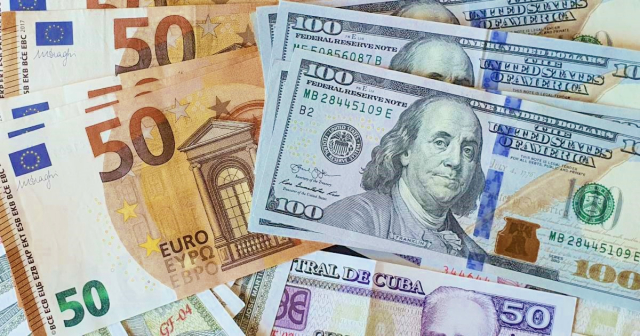For the third consecutive day the dollar and the euro wake up with price increases and new record sales figures in the Cuban informal market.
The US currency rises two pesos and reaches 392 CUP.
Especially relevant is the strong increase in the euro, which is above 400 CUP after raising five pesos at once, as announced on May 8 by the independent media elToque, which monitors currency fluctuations in street-level marketing.
The Freely Convertible Currency (MLC), for its part, This Wednesday it remains at 390 CUP, a price that reached on May 4.
Exchange rate today 05/08/2024 - 7:15 a.m. in Cuba:
Exchange rate from USD to CUP according to elTOQUE: 392 CUP.
Euro exchange rate EUR to CUP according to elTOQUE: 400 CUP.
MLC to CUP exchange rate according to elTOQUE: 300 CUP.
Alternative exchange rate from other platforms:
Dollar (USD) exchange rate: Buy 389 CUP, Sell 391 CUP.
Euro (EUR) exchange rate: Buy 396 CUP, Sell 397 CUP.
MLC exchange rate: Buy 300 CUP, Sell 300 CUP.
The informal Cuba exchange rate offered here is not officially recognized or endorsed by any financial or government entity.
Below are the equivalents of each available banknote from euros and US dollars to Cuban pesos (CUP) according to the exchange rates of this May 8, 2024.
US Dollar (USD) to Cuban Peso (CUP):
1 USD = 392 CUP
5 USD = 1960 CUP
10 USD = 3920 CUP
20 USD = 7840 CUP
50 USD = 19600 CUP
100 USD = 39200 CUP
Euro (EUR) to Cuban Peso (CUP):
1 EUR = 400 CUP
5 EUR = 2000 CUP
10 EUR = 4000 CUP
20 EUR = 8000 CUP
50 EUR = 20000 CUP
100 EUR = 40000 CUP
This information can be useful to calculate the cost in Cuban pesos of any amount in dollars or euros.
These rates are applied according to the current values of the informal market in Cuba.
While the informal price of foreign currency remains without a ceiling in Cuba, inflation also continues uncontrolled, leaving a bleak panorama in which Cubans see how they lose their purchasing power day after day.
In the midst of this scenario, the Cuban regime seems to find itself in a dead end, unable to offer economic solutions to the problem and opting to blame the devaluation of the CUP on elToque.
Do you think that the publication of the elTOQUE rate can really influence the price of the dollar and other currencies in the informal market? Is this a legitimate debate?”, the independent media asked its readers in recent days, while breaking down into a detailed analysis the result of a study by the Observatory of Currencies and Finance (OMFi) on the subject.
Between January 2021 and April 2024, the Cuban peso has depreciated 660% against the US dollar in the parallel market. The informal exchange rate coexists with two widely overvalued official exchange rates.
The main reference - although it is not the only one - of the value of the Cuban peso in the informal market comes from the independent multimedia platform elToque, which has been extracting and processing information on Cuba's parallel currency market using a novel methodology.
The independent media reiterated that the data is obtained from social networks and websites through artificial intelligence algorithms that allow natural language processing (NLP). Algorithms identify and extract information about who buys, who sells, what currency, at what rate and what amount.
The publication of the representative exchange rate of the informal market (TRMI) since elToque It has generated an intense debate in which detractors and defenders confront each other, who use all kinds of arguments, extreme political positions, limited financial education and conspiracy theories.
The intolerance of the Cuban Government towards an information medium critical of official policies constitutes a motivating factor for disinformation campaigns that occur in the state press and on social networks.
"Blaming the devaluation of the peso and inflation on an external entity fits well within the script that the Government has used for decades to evade responsibilities and divert attention", he concluded elToque.
At the end of January Miguel Diaz-Canel, through his then Minister of Economy and Planning, Alejandro Gil Fernandez, announced that he was prepared to the intervention of the informal foreign exchange market in February.
The Presidency of Cuba indicated that the government would advance “in the presentation of proposals to resize the exchange market, the intervention of the informal sector and the control of the exchange rate in the country,” although no details of the interventionist plan were offered.
In this sense, they indicated that the actions to be developed included “the determination of the exchange rate and the formation of prices.” However, after the dismissal of Gil Fernández, the issue of intervention in the informal currency market has ghostly appearances in official rhetoric without taking shape in reality.
What do you think?
COMMENTFiled in:
